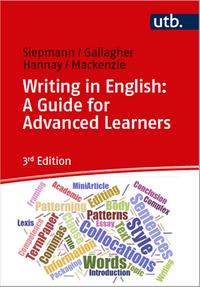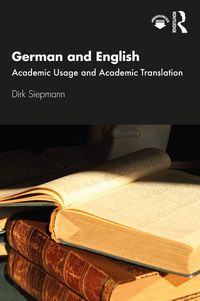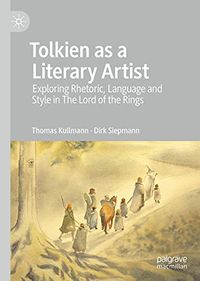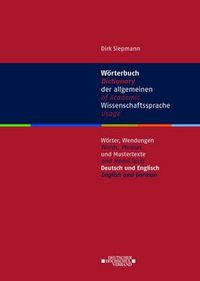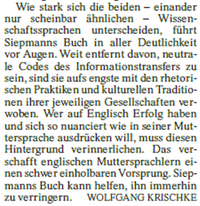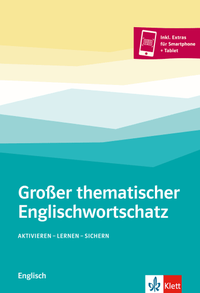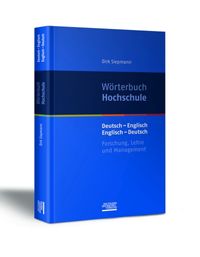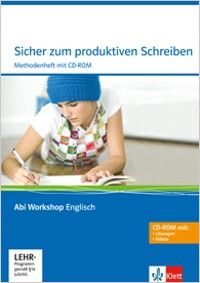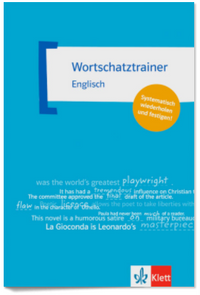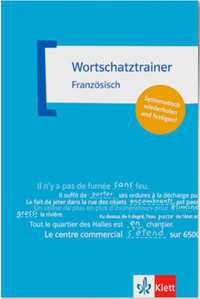Books
Books for a general audience published from 2010 to 2024.
2022-24: Grammatik des gesprochenen und geschriebenen Französisch. Band 1: Verb und Satz, Band 2: Das Nomen., Band 4: Adverbiale, Fürwörter, Pronomen (for more information, see volume 3 on adjectives below)
2021
Writing in English. A Guide for Advanced Learners (3rd edition). Tübingen: Narr. (with Lachlan Mackenzie, Mike Hannay and John D. Gallagher)
Reviewed by Dr. Karoline Lukaschek, Prof. Dr. Peter Bünder (www.socialnet.de), Christine Brengelmann (Uni Online): "Dieses 460 Seiten dicke Buch bietet wirklich alles, was der ambitionierte Anglistik/Amerikanistik-Student zum Thema „academic writing“ sucht!"
"Allen Studierenden, die mit dem Gedanken eines Auslandssemesters spielen, kann dieses Buch sehr empfohlen werden. Zu hoffen ist, dass es einen festen Platz in den Lehrbuchsammlungen der Hochschulen erhält."
About Writing in English
The reader may justifiably wonder what is new about this book. After all, there is already a plethora of style guides, composition textbooks and self-help Internet sites giving advice on professional or academic writing in English. This book is different in at least two respects. Firstly, while we do offer advice on how to write effectively, our advice is not based on any prescriptive notions of what constitutes a ‘good’ text. Rather, we attempt to offer objective insights into those features of English academic text that may pose problems for the German-speaking writer of English. To take just one example, some style guides intended for native speakers set out fairly rigid rules on nominalization, claiming that texts will be easier to understand if the writer uses as few nominalizations as possible. However, as close observation of academic text will show, the situation is far more complex. One reason is that nominalization is a standard feature of academic language; this is just as true for English as for any other European language. As a result, budding academic writers who are anxious to join the academic community have no alternative but to use nominalizations in conformity with academic norms. Another reason is that the choice between a nominal and a verbal construction often depends on context. In the following sentence, for example, the noun supersession is clearly preferable to its verbal equivalent supersede, whose use would make the sentence far longer and more complex. This is because the verbs advocate and expect take different complements (e.g. advocate that + subjunctive, expect that + will-future):
Most of those who advocate or expect the supersession of capitalism by socialism have a strong sympathy with the idea of socialism and, indeed, call themselves socialists. (Robinson 1980: 141)
Similar observations could be made about countless other points we discuss in this book. In each case, rather than providing prescriptive rules, we aim to provide strategies and exercises designed to help our readers cope with the twin demands of effectiveness and conformity to discoursal norms. The assumption throughout is that a reader who has insight into language, and more specifically into the interplay between function and form, will be able to make the right choices at any particular juncture in a text.
Intimately connected with this is a second feature that sets Writing in English apart from general textbooks on writing: it is geared specifically towards the needs of German-speaking readers. We base all our observations on authentic student and native-speaker texts from various sources, some of them electronic, and we draw on a wide range of research literature, some of which deals with cross-linguistic and cross-cultural difference. We are confident that this corpus-driven approach has allowed us to describe deviation and error in students’ interlanguage with greater precision than is the case in textbooks which are aimed at a more general audience. In this sense, the present book will be helpful not only to non-native writers, but also to native editors struggling to correct fully formulated texts submitted by German-speaking authors.
Preface to the Third Edition
This third edition includes a number of updates and minor corrections to the text of the Second Edition; the text has also been streamlined where necessary.
These modifications are designed to take account of new insights that have emerged in the technical literature. The ten years since the second edition have also seen an accelerated globalization of higher education, and with it a further broadening of the academic discourse community writing in English.
This in turn has led to increased interest in the standards that should apply in the assessment of written academic English (cf. Jenkins 2014, Ch.3).
Although we acknowledge the movement towards English as a lingua franca in academic settings (ELFA), we continue to support native speaker English as the target model for advanced learner writers. There is as yet insufficient strong evidence that the target norms have changed (cf. for instance Edwards 2016).
Finally, in response to the widespread use of the internet by student writers, this edition devotes more attention than its predecessors to internet tools (the electronic workbench) and to plagiarism.
German and English: Academic Usage and Academic Translation. London/New York: Routledge.
About
German and English: Academic Usage and Academic Translation focuses on academic and popular scientific/academic usage.
The book’s brief is both theoretical and practical: on the theoretical side, it aims to provide a systematic, corpus-based account of current academic usage in English and in German as well as of the translation problems associated with various academic genres; on the practical side, it seeks to equip academic translators with the skills required to produce target-language text in accordance with disciplinary conventions. The main perspective taken is that of a translator working from German into English, but the converse direction is also regularly taken into account. Most of the examples used are based on errors that occurred in real-life translation jobs. Additional practice materials and sample translations are available as eResources here: www.routledge.com/9780367619022.
The book is an important resource for professionals aspiring to translate academic texts, linguists interested in academic usage, translation scholars, and graduate and post-graduate students.
German and English. Academic Usage and Academic Translation. London/New York: Routledge.
Tolkien as a Literary Artist. London: Palgrave/Macmillan. (with Thomas Kullmann)
Reviewed by Tolkien scholar Tom Shippey:
"In all the copious body of criticism devoted to Tolkien, there has been one great gap: analysis of his sheer ability as a writer, not least his capacity to vary styles from epic to novelistic, and his skill at establishing character through dialogue. The gap has now been filled by this very welcome work from Professors Kullmann and Siepmann, which opens the way for a proper appreciation, both of Tolkien’s own art, and his true place in literary history."
About
This book takes a fresh look at Tolkien’s literary artistry from the points of view of both linguistics and literary history, with the aim of shedding light on the literary techniques used in The Lord of the Rings. The authors study Tolkien’s use of words, style, narrative techniques, rhetoric and symbolism to highlight his status as a literary artist.
Dirk Siepmann uses a corpus stylistic approach to analysing Tolkien’s vocabulary and syntax, while Thomas Kullmann uses discourse theory, literary history and concepts of intertextuality to explore Tolkien’s literary techniques, relating them to the history of English fiction and poetry. Issues discussed include point of view, speeches, storytelling, landscape descriptions, the poems inserted into the body of the narrative, and the role of language in the characterization of the novel’s protagonists. The book will be of particular interest to students and scholars of literature, corpus linguists and stylisticians, as well as Tolkien specialists and fans.
Tolkien as a Literary Artist. Exploring Rhetoric, Language and Style in The Lord of the Rings.
Palgrave Macmillan 2021. (with Thomas Kullmann)
2020
Wörterbuch der allgemeinen Wissenschaftssprache. Bonn: DHV.
About
This dictionary has been designed to help anyone aspiring to expertise in writing or speaking academic English or German, whether native or non-native speakers, students or teachers, beginners or advanced learners, hard scientists or social scientists. To work successfully with this book, users should have attained the B2 level of the Common European Framework of Reference for Languages. Regular consultation of the book will enable the user to gain mastery of academic usage at the C2 level and beyond. Especially in the humanities and social sciences, such mastery is of paramount importance to be able to cope with the conceptual complexities of their subject matter - the historical, social, material, etc. roots and circumstances of human existence.[1] Writing in the hard sciences requires less ‘artistic’ skill but nonetheless a confident command of the basic routines involved in formulating the research process.
The book can be used in a wide variety of settings, such as practical language courses preparatory to, or concurrent with, university-level degree programmes as well as English for Academic Purposes (EAP) and Deutsch als Wissenschaftssprache courses at colleges, language schools and Goetheinstitute. It can be read from cover to cover or dipped into for guidance on specific points.
In using this book, writers and speakers can, if they wish, focus on just one of the languages discussed. Different learning needs and scenarios can be imagined, leading to different uses of the book, ranging from German researchers having to publish journal articles in English, via students who need to learn academic German to pursue a degree program, through to native speakers of English who wish to read books or articles written in German or watch German lectures on the Internet. Whatever the user’s needs, it is the author’s contention that the opportunity for interlingual comparison that the book provides is a unique feature that may help users eliminate typical mistakes, increase their linguistic sensitivity and improve their style.
1) Reinhard Schmidt, Wissenschaftssprache und sozialwissenschaftliche Übersetzung im deutsch-italienischen Sprachvergleich. Tübingen: Stauffenburg 2017, 111.
(Frankfurter Allgemeine Zeitung, 27.11.2020)
2019
Grammatik des gesprochenen und geschriebenen Französisch. Band 3: Das Adjektiv. (A Grammar of Spoken and Written French)
About
A Grammar of Spoken and Written French offers a new and authentic approach to French grammar. Based on a representative collection of texts (usually called a ‘corpus’) it covers the full breadth and depth of present-day French. This means that it never considers grammatical phenomena in isolation, but rather takes full account of the ways in which they combine with lexical items and are used in real text. Special attention is paid to the questions of which forms speakers use with particular frequency and how these forms are distributed across the spoken and the written language or across a variety of genres.
A Grammar of Spoken and Written French is a stand-alone grammar for learning, reference and practice and is intended for students whose command of the language has reached level B1 of the Common European Framework. It takes the tried and tested model of a grammar that provides examples and rules and supplements it with a lexical component. For most grammar patterns, it starts by covering the set(s) of lexical items found in each pattern, sometimes grouping items by topic; this is usually followed by examples illustrating the interplay of vocabulary and grammar; finally, where appropriate, a rule is formulated that follows logically from the examples given.
All the French examples come from the corpus, a practice which breaks with the tradition of all previous French grammars for learners which contrive examples for the purpose of teaching the language rather than using carefully selected specimens of contemporary usage. For ease of comprehension, most examples have been translated into English. In addition, translation is regularly used to compare English and French patterns with a view to highlighting interlingual difference and preventing interference – an extra benefit of translation being that users of this grammar will acquire a great deal of new vocabulary en passant. Although designed as a learner’s grammar, A Grammar of Spoken and Written French also breaks some new ground in the linguistic description of French.
There can be no grammar without a norm. Without norms, individual variation in language use would increase to such an extent that mutual comprehension would be impaired or rendered impossible. A Grammar of Spoken and Written French relies on an empirical norm which encompasses the selections attested in a representative corpus over a considerable length of time. It thus departs somewhat from the traditional French view that only the best authors can serve as normative models. As Meißner (2006: 248-249) has argued, in an attempt to answer the question ‘quel français enseigner?’ (‘what kind of French should we teach?’), television has long provided the uncontested statistical norm for spoken French by bringing numerous idiolects and linguistic varieties to the eyes and ears of a mass audience, while at the same time presenting them in such a way that they can be understood by the vast majority of viewers and listeners. With regard to the written language, the corpus used draws on fiction, newspapers and magazines, academic and popular scientific works as well as miscellaneous texts in everyday use. The establishment of this new norm has entailed numerous revisions of earlier work; thus, to take just one small example, the use of espérer with the subjunctive is portrayed as norm-conforming since it occurs in around half of all cases.
2018
Grammatik des gesprochenen und geschriebenen Französisch. Band 5: Präpositionen.
A Grammar of Spoken and Written French. Volume 5: Prepositions.
2017
2016
Wörterbuch Hochschule. Forschung, Lehre und Management. Bonn: DHV.
Reviewed by Peter A. Schmitt in Lebende Sprachen:
„Bei meinen Stichproben zu den verschiedensten Hochschulbereichen ist mir kein einziger Eintrag aufgefallen, der in dieser (oder einer anderen) Hinsicht defekt war.
In rund 35 Jahren im Hochschuldienst, darunter viele Jahre als Studiendekan, Institutsdirektor und Vorsitzender des Prüfungsausschusses, sowie als Tagungsorganisator und Drittmittelantragssteller habe ich viele Facetten des Hochschulbetriebs kennengelernt, und ich war oft in der Verlegenheit, darüber in englischer Sprache schreiben zu müssen - ich wünschte, ich hätte bereits früher dieses Wörterbuch als Werkzeug zur Hand gehabt.
Absolute Kaufempfehlung, mindestens für die Professoren, aber eigentlich für alle Hochschulmitarbeiter.“
Wörterbuch Hochschule.
Bonn: DHV 2015 (4. Aufl. 2020).
2012
Wissenschaftliche Texte auf Englisch schreiben.
Leitfaden für die Praxis. Stuttgart: Klett 2012.
